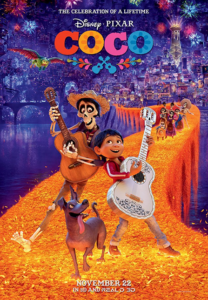
 After the lightweight cash grab that was this summer’s weak “Cars 3,” for inspiration, Pixar appropriates the Mexican holiday Dia de los Muertos (The Day of the Dead). The result is a blunt, manic film that is worthy of their award-winning canon, but not as important as it should have been.
After the lightweight cash grab that was this summer’s weak “Cars 3,” for inspiration, Pixar appropriates the Mexican holiday Dia de los Muertos (The Day of the Dead). The result is a blunt, manic film that is worthy of their award-winning canon, but not as important as it should have been.
When the young Miguel (voiced by Anthony Gonzalez) tries to embrace his love for music, his grandmother and relatives forbid him to do so. Generations earlier, Miguel’s ancestor left his family in order to pursue a career as a musician. Therefore, music has been banned in his household. Of course, this ban only makes Miguel pursue that which is forbidden even more. In time, he runs away only to find himself traveling back to the actual Land of the Dead in pursuit of answers to a nagging family mystery.
Surprisingly, the problems with “Coco” are partially rooted in mass audience unfamiliarity with the Day of the Dead celebration. While I’m sure that some viewers will have cultural basis upon which to draw, I only knew of the holiday based on the artwork that often included colorful skulls. And the “Coco” script does not acquaint us with enough context from which to understand the traditions.
So, when Miguel is spirited off to the Land of Dead, very little distinguishes it from other animated fantastical realms. It is frustrating as Miguel, who is not yet a member of the Dead community, has to conceal himself and is later pursued by his dearly departed relatives that have taken up residence in this odd place. From what I was able to gather, when you die, your spirit is transported to the Land of the Dead, where you look like you looked when you died only you are a skeleton version of your former self.
The governmental structure of the place is completely inconsistent. Famous singer and movie star Ernesto de la Cruz (voiced by Benjamin Brett) appears to run some kind of fiefdom. He lives in a palace of some sort where he throws marvelous parties. The skeleton inhabitants eat, drink, and make merry even though they don’t seem to have any reason to require food. The source of de la Cruz’ great wealth is directly tied to the land of the living where tributes are placed at his grave that can be used in the Land of the Dead.
From a narrative and animation standpoint, the Land of the Dead plays fast and loose with the perceived “rules” of Dia de los Muertos. By culturally appropriating the holiday, director’s Lee Unkrich and Adrian Molina appear to be unrestrained in building their own universe on top of it. Therefore, we get a strange town in the Land of the Dead, where all the residents literally worship de la Cruz. This weird place has television cameras and convenient technology when the plot requires it. The resolution of the mystery isn’t very clever, which is a real shame.
What’s missing is a wonderful Pixar montage that sets up the story in an emotionally connective way (“Up” and “WALL-E” can be cited as superior examples). Sure, we learn about Miguel’s family, but the key missing contextual elements are establishment of the rules of the Dia de los Muertos holiday. This permits the writers at any given moment to merely invent things, like a flying dragon-like spirit animal, or provide de la Cruz with an army of bodyguards (wearing, I kid you not, black suits and earpieces). The constantly transforming kaleidoscope of imagery is colorful and, at times, fun, but manically distracting at other times.
Thankfully, the frayed story elements are pulled together in “Coco’s” conclusion, that will leave you with a lump in your throat. It’s just that getting there is not nearly worthy of the genuine sentiment ultimately evoked.
For a production company that built its empire upon talking toys, my complaints that “Coco” isn’t concrete enough may come off as foolish. But where “Toy Story” made you understand and appreciate in a very tangible way the world inhabited by Woody and Buzz, “Coco” is relatively weightless. And this means that the film shares more in common with this year’s other Pixar entry “Cars 3” rather than its last great film 2015’s “Inside Out.”
